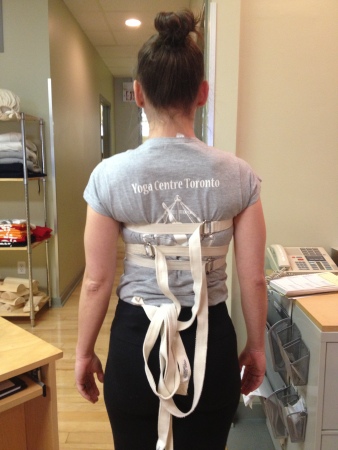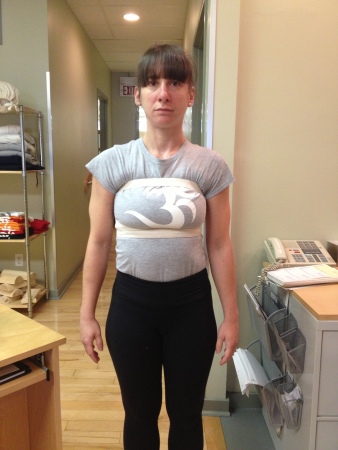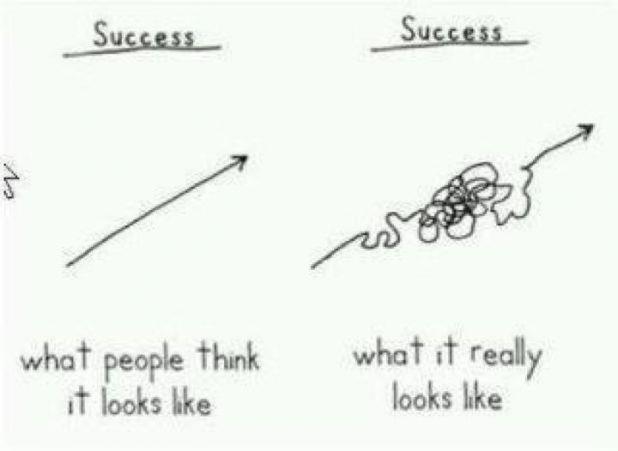Ever get the feeling like your yoga practice is moving in the wrong direction? You are not alone!!
In my last post, I shared a window into my personal practice. One of the photosfrom that practice session highlighted the scoliosis in my back. I was very surprised (& also appalled!) to see just how intensely my scoliosis had progressed. I admit that when it comes to my spine, I get really nervous about any new pains and unusual changes. I have a long history with debilitating back pain and even though I have improved dramatically it doesn’t take much for the fear to surface – the fear of undoing all the good progress I have made to date.
Fear of pain is certainly a great motivator and my practice these days is very much informed by trying to even myself out. Can I get my hips level? Can I get my shoulders to level? I’ve become particularly aware of the left side of my trunk and how its tendency is to shrink. Similarly, I’m acutely aware of the lack of feeling I experience on the left thoracic area of my back (this is the area of my back that is concave). Mr. Iyengar says that when you have imbalances, you have to let the good side teach the bad side. Even though my right side is far from ‘good’, it at least has feeling so I’ve been trying to recreate that sensation on my left.
My teacher has me practicing with straps. The straps are positioned in such a way that the very tip of the right shoulder blade which generally goes all wonky (that’s my convex side) is pulled back in towards my spine. On the one hand I like the straps because they feel supportive. I also like the frame of reference they give me on the back side of the body. Because of the scoliosis, it feels as though the strap is tighter on my right side. As a result, I can manipulate my chest/ribs/trunk to equalize the touch of my back to the straps. I find this immediate feedback really useful. All that said, working with the straps has been a bit intense.


I feel like I’m learning all of the asanas, again, for the first time! I’m beside myself in my own body. My inversions, in particular, are a mess. In my effort to straighten out my trunk, I’ve completely lost my stability. And while I am excited about the idea of bringing consciousness to an area of my body that has been extremely elusive to me, I admit, this process is somewhat frustrating.
I’m reminded though of some things my students say to me: “I can do Sirsasana in the middle of the room, why do you want me at the wall?” “I can do Supta Padangusthasana without props, why do you want me to use a strap?” “Last week I didn’t need a block in Utthita Trikonasana, why are you giving me one today?” Depending on the context of these comments, I generally respond with one of the following explanations:
- We are using the wall/the block/the strap to learn. Listen carefully to the instructions and see what you can learn about your pose by backing it up in this manner. Afterwards, practice without the prop and see if you can translate the lesson.
- Just because you are not stable in the pose today, does not mean you wont be stable in it tomorrow, and it certainly doesn’t cancel out the stability you may have had in the past.
- Sometimes as you progress in one area of the body, another area of weakness appears. Yoga is infinitely rich with so much to teach. When this happens to me, I like to think of it as a sign that progress has occurred and my body is revealing my next challenge.
- Sometimes as you make progress in your practice, you need to give yourself time to adjust to the ‘new normal’. For example, if you do a lot of work opening the chest and getting into the shoulder blade area, you may find yourself wobbly in Sirsasana (headstand). This is likely because you’ve penetrated, you’ve gone deeper than before. It is not necessarily a weakness, rather a new baseline that you need to become accustomed with.
- Some days you need support, some days you don’t. Know yourself. Be honest with yourself. Take support if you need it, leave it if you don’t.
And as I try to understand the curve in my spine and integrate that understanding into my practice, I think I have reminded myself of the above points on a daily basis. I am indebted to my students for helping to keep me honest – thank-you! Interesting how, no matter where we are at with our practice, we bump up against similar obstacles  .
.
As I take to the mat today, it’s BKS Iyengar’s words that are most meaningful, motivating and endlessly inspiring:
“Do not allow past experiences to be imprinted on your mind. Perform asanas each time with a fresh mind and with a fresh approach. If you are repeating what you did before, you are living in the memory, so you are living in the past. That means you don’t want to proceed beyond the experience of the past. Retaining that memory is saying, ‘Yesterday I did it like that.’ When I ask, ‘Is there anything new from what I did yesterday?’ then there is progress. Am I going forward or am I going backward? Then you understand how to create dynamism in a static asana.”
– BKS Iyengar in Light on Life





